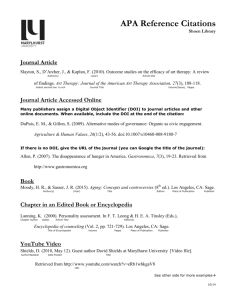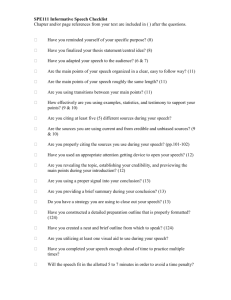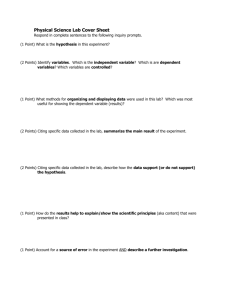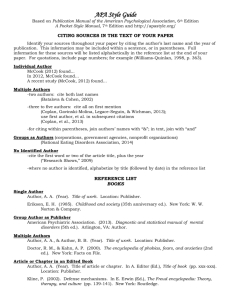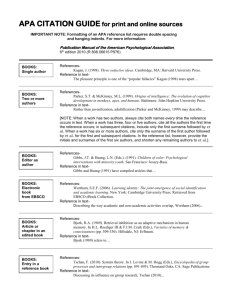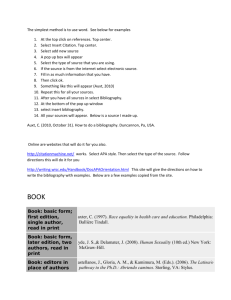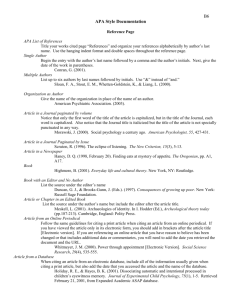APA
advertisement
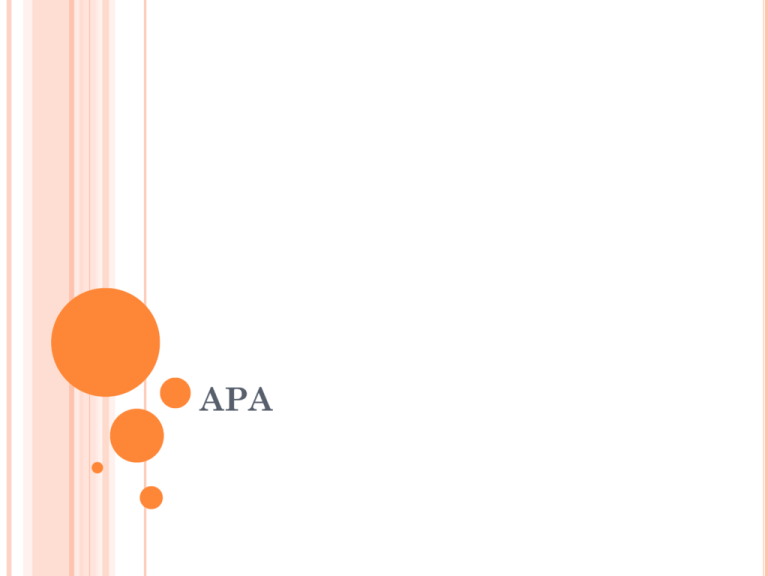
APA REVIEW OF LITERATURE A literature review is helpful as it lets the researchers gather the ideas of others who are interested in a particular research question read about the results of other similar or related studies Thus, researchers will be able to locate other work dealing with their intended area of study evaluate this work in terms of its relevance to the research question of interest STEPS IN A LITERATURE REVIEW Decide on a topic; identify key words Look through sources using your key words Skim the articles to get a general idea of the purpose and content of the article Group the articles into categories STEPS IN A LITERATURE REVIEW Take notes while reading Define key terms (note the differences in the definitions of the key terms) Select useful quotations you might include in your review (note author name, volume no., page no. etc.) Note (and critique) the research methodologies, findings and conclusions in the studies Identify relationships among the studies Make sure all the points you have noted are relevant to your topic Keep in mind: you should stop somewhere!! STEPS IN A LITERATURE REVIEW Write the literature review Develop critical skills. Simple summary is not enough for literature review. It is NOT series of annotations. This does NOT mean to criticize the work of others; ask questions about the significance of the work and make connections between the other readings you have done Indicate why certain studies are important Cite all the studies appropriately Use your review of the literature as a means of showing why your research questions are important. E.g. If there is a lot of research in literature about the general topic of your research field (X), but just a little or no research on a sub-topic (X1), you can justify this assertion in your literature review. CITING STUDIES IN THE TEXT American Psychological Association Style (APA6th edition) In research others’ ideas and words must be formally acknowledged. This is done by citing original documents in the text and then documenting all these studies in an alphabetical order in the Reference section. Citing others’ work can be done directly or indirectly. PS. Only surnames of the authors are used!! INDIRECT CITATION CITING A WORK BY SINGLE AUTHOR If the name of the author appears in the text: Thus, there have been concerns regarding the effectiveness of standardized testing in assessing writing. In an attempt to overcome some of the problems associated with standardized testing, many researchers have advocated assessment procedures that are ongoing and process-oriented. For example, Stiggens (2005) calls for the use of assessment for learning models that focus on ongoing formative assessment of students’ progress rather than the widely used assessment of learning models which are more static in nature and are limited to testing the end product of learning through measuring students’ achievement rather than their progress. If the name of the author does not appear in the text: The advent of DA is relatively new in the field of educational assessment in general and in the field of second language assessment in particular (Ableeva, 2009). If you need to cite more than one article of the same author in the same year: Unfortunately, this proliferation of research addressing ESL writing, on the one hand, and socio-cultural learning theories, on the other, has not yet been paralleled with the same enthusiasm to find writing assessment methods reflecting the socio-cultural nature of learning which can be used as alternatives to standardized testing since the latter has been continuously criticized for its being an invalid writing assessment method (Hamp-Lyons, 1990a). The use of standardized tests in assessing writing has received even more criticism since the use of such an assessment procedure does not seem to accurately measure writing ability (Hamp-Lyons, 1990b). CITING A WORK BY TWO AUTHORS Surnames of both authors are used all the time: According to Lantolf and Poehner (2005), formative assessment methods seem to implicitly consider assessment and instruction as two separate entities where the role of assessment is simply to bring about change in instruction. Following that, a review of literature on formative assessment is presented since formative assessment can be considered one way to overcome many of the problems associated with standardized testing in addition to being compared to DA in aiming for ongoing assessment rather than focusing on final achievement testing only (Lantolf & Poehner, 2005). CITING A WORK WITH 3 OR MORE AUTHORS Write all the names when you first cite them: The theoretical underpinnings of DA can be traced back to the Vygotskian concept of Zone of Proximal Development and the theory of Mediated Learning Experience (Feuerstein, Rand & Hoffman, 1979). In subsequent citations, include only the surname of the first author followed by ‘et al’. Thus, one can see the similarities between Vygotsky’s ZPD and Feuerstein et al. (1979) MLE since both emphasize the role of intervention by a more capable peer in promoting development. Citing an edited work You should mention only the name of the author, not the editor. Citing groups as authors When cited the first time, the name of the group is written. In 2000, Department of Immigration and Ethnic Affairs (DIEA) … Use the abbreviation when cited again DIEA (2000) reported that… CITING MULTIPLE REFERENCES If we need to cite multiple references for the same idea, use either alphabetic or chronologic order and separate author groups with a semicolon. It is worth noting that whereas Lidz’s (1987) definition seems to emphasize that the goal of DA is mainly to achieve cognitive modifiability, more recent definitions of DA (Ableeva, 2009; Anton, 2009; Poehner, 2005) stress the social rather than cognitive aspect of this assessment procedure. CITING WORKS WITH NO AUTHORS If a work does not have author, use the first two or three words of the title and capitalize each word. Italicize them and use double quotation mars A special one-off visa category was announced (“Assessment Criteria”, 2001). DIRECT CITATION If you want to use others’ words as they are, you must use quotations and the page number. For a quotation of fewer than 40 words (4 lines) Testing, on the other hand, is “a special form of assessment administered under contrived circumstances. In other words, all tests are assessments, but not all assessments are tests’’ (Kizlik, 2009, p. 1). Lantolf and Poehner (2004) contend that “dynamic assessment integrates assessment and instruction into a seamless, unified activity aimed at promoting learner development through appropriate forms of mediation that are sensitive to the individual‘s (or in some cases a group‘s) current abilities” (p. 50). A quotation of more than 40 words must be set apart from the text (block quotation). The left margin of the block should be set in from the left margin by the same spacing as the first line of a new paragraph. Sample 1 In accordance with this point of view, Yancey (1999) further adds the following: This model of writing assessment, with its different genres and multiple texts and classroom writing environment, seemed more valid still. But built into the model was another new feature, a reliability based not on statistics, but on reading and interpretation and negotiation. (p. 492) Sample 2 …that it is sometimes necessary for testing to lead the way: We believe that language testers can serve linguistic theory by examining the way in which their tests work, how their different components interrelate, and what they reveal about candidates’ language proficiency. Insights from such an analysis of test results should contribute to the development of a better understanding of what is involved in knowing and using language. (Alderson, 1992, p. 164) LIST OF REFERENCES BOOKS One Author King, M. (2000). Wrestling with the angel: A life of Janet Frame. Auckland, New Zealand: Viking. Two authors Treviño, L. K. & Nelson. K. A. (2007). Managing business ethics: Straight talk about how to do it right. Hoboken, NJ:Wiley. Three authors and above Krause, K.-L., Bochner, S., & Duchesne, S. (2006). Educational psychology for learning and teaching (2nd ed.). South Melbourne, Vic., Australia: Thomson. Electronic with NO DOI Will, R. J. (2002). The characteristic symphony in the age of Haydn and Beethoven [Ebrary Reader version]. Retrieved from Ebrary database. Electronic with DOI Larochelle, M., Bednarz, N., & Garrison, J. (2010). Constructivism and Education. doi:10.1017/CBO9780511752865 N.B. Although the book was first published in print in 1998, this online version is published in 2010. Use 2010 as the year of publication Book or report by a corporate / group author World Health Organization (2008). WHO global report on falls prevention in older age. Geneva, Switzerland: Author. BOOK CHAPTERS Chapter in an edited book Helber, L. E. (1995). Redeveloping mature resorts for new markets. In M. V. Conlin & T. Baum (Eds.), Island tourism: Management principles and practice (pp. 105-113). Chichester, England: Wiley. Bergquist, J. M. (1992). German Americans. In J. D. Buenker & L. A. Ratner (Eds.), Multiculturalism in the United States: A comparative guide to acculturation and ethnicity (pp. 53-76). New York, NY: Greenwood. Thesis/Dissertations Dewstow, R. A. (2006). Using the Internet to enhance teaching at the University of Waikato (Unpublished master's thesis). University of Waikato, Hamilton, New Zealand. PERIODICALS/JOURNALS Journal Article /Printed Shepherd, R. (2008). Strategic position and performance of winter destinations. Tourism Review, 63(4), 40-57. Journal Article with a DOI Shepherd, R., Barnett, J., & Walton, C. (2007). Towards an understanding of British public attitudes concerning human cloning. Social Science & Medicine, 65(2), 377-392. doi:10.1016/j.socscimed.2007.03.018. Journal Articles with NO DOI Harrison, B., & Papa, R. (2005). The development of an indigenous knowledge program in a New Zealand Maori-language immersion school. Anthropology and Education Quarterly, 36(1), 5772. Retrieved from Academic Research Library database. Journal Article / Internet Only Snell, D., & Hodgetts, D. (n.d.). The psychology of heavy metal communities and white supremacy. Te Kura Kete Aronui, 1. Retrieved from http://www.waikato.ac.nz/wfass/tkka. WEBPAGES Statistics New Zealand. (2007). New Zealand in profile 2007. Retrieved from http://www.stats.govt.nz. University of Waikato, Law Library. (n.d.). Commentary. Retrieved July 19, 2009, from http://law.waikato.ac.nz:8080/lrs/index. References Black, P. & Wiliam, D. (1998). Assessment and classroom learning. Assessment in Education, 5(1), 7-74. Black, P. & Williams D. (2004). Inside the black box: raising standards through classroom assessment. In S. Chappuis, R. J. Stiggins, J. Arter, and J. Chappuis (Eds.), Assessment for Learning: An Action Guide for School Leaders (pp. 10-21). Portland, OR: Assessment Training Institute. Boud, D. (2000). Sustainable assessment: rethinking assessment for the learning society. Studies in Continuing Education, 22(2), 151-167. Clapham, C. (2000). Assessment and testing. Annual Review of Applied Linguistics, 20, 147-161. Gaines, B. R. & Shaw, M. (2010). Webgrid 5. http://gigi.cpsc.ucalgary.ca:2000 Hamp-Lyons, L. (2007). The impact of testing practices on teaching: ideologies and alternatives. In J. Cummins and C. Davison (Eds.), The International Handbook of English Language Teaching, Vol. 1 (pp. 487-504). Norwell, MA: Springer.
